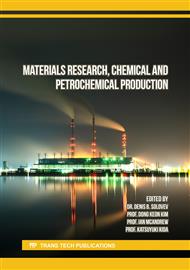[1]
R.M. Karimov, B.N. Mastobaev, Change in the technology of pumping oil on the "Uzen - Atyrau - Samara", oil pipeline with the development of the oil transportation system of Western Kazakhstan Transport and storage of oil products and hydrocarbons. 2 (2010) 9-14.
Google Scholar
[2]
R.M. Karimov, B.N. Mastobaev, Rheological features of the West Kazakhstan oil mixture, Transport and storage of oil products and hydrocarbon raw materials. 2 (2011) 3–7.
Google Scholar
[3]
R.M. Karimov, B.N. Mastobaev, Joint transport of high-viscosity and highly solidifying oils of Western Kazakhstan via the "Uzen - Atyrau - Samara" oil pipeline, Transport and storage of oil products and hydrocarbons, 1, 3–6.
Google Scholar
[4]
P.A. Revel-Muroz, R.N. Bakhtizin, R.M. Karimov, B.N. Mastobaev, Joint pumping of heavy and highly paraffinic oils in a mixture, Socar Proceedings, Scientific works. 2 (2018).
Google Scholar
[5]
R.N. Bakhtizin, R.M. Karimov, B.N. Mastobaev, Influence of high-molecular components on rheological properties depending on the structural-group and fractional composition of oil, Socar Proceedings, Scientific works. 1 (2016).
DOI: 10.5510/ogp20160100269
Google Scholar
[6]
P.A. Revel-Muroz, R.N. Bakhtizin, R.M. Karimov, B.N. Mastobaev, Joint use of thermal and chemical methods of exposure during the transportation of high-viscosity and solidifying oils, Socar Proceedings, Scientific works, 2 (2017).
DOI: 10.5510/ogp20170200314
Google Scholar
[7]
R.M. Karimov, A.V. Zaplatin, R.R. Tashbulatov, Use of twisted heat exchangers made of small-radius coils for heating and heat treatment of oil, Publishing house of Information Agency Neftegaz.RU International. 12 (2018) 45-49.
Google Scholar
[8]
R.M. Karimov, R.R. Tashbulatov, A.V. Zaplatin, Coiled Heat Exchanger with Small Radius Bent Tubes for Controlled Heat Treatment of High Viscosity Waxy Oil, IOP Conf. Series: Earth and Environmental Science. 272 (2019) 022193, doi: 10.1088 / 1755-1315 / 272/2/022193
DOI: 10.1088/1755-1315/272/2/022193
Google Scholar
[9]
RD 39-30-139-79, Method of thermal hydraulic calculation of main pipelines under stationary and non-stationary modes of pumping, Newtonian and non-Newtonian oils in various climatic conditions.
Google Scholar
[10]
RD 39-30-648-81, Method for determining starting pressure for oil pipelines transporting paraffinic oils.
Google Scholar
[11]
RD-39-0147103-329-86, Methods for determining the rheological parameters of highly solidifying oils.
Google Scholar
[12]
R.M. Karimov, B.N. Mastobaev, Features of pipeline transport of multicomponent systems, Azerbaijan Oil Industry. 1 (2012) 60-63.
Google Scholar
[13]
A.Sh. Akzhigitov, On the rheological curve of non-Newtonian oil, Oil and gas. 3 (2007) 53-56.
Google Scholar
[14]
R.N. Bakhtizin, R.M. Karimov, B.N. Mastobaev, Generalized flow curve and universal rheological model of oil, Socar Proceedings, Scientific works. 2 (2016).
DOI: 10.5510/ogp20160200277
Google Scholar
[15]
R.R. Tashbulatov, R.M. Karimov, B.N. Mastobaev, A.R. Valeev, Approximation of the rheological curve in low-temperature zones of anomalous flow of non-Newtonian oils using an asymptotic model, Pipeline transport, Theory and practice. 4 (2017) 62.
Google Scholar
[16]
R.R. Tashbulatov, R.M. Karimov, B.N. Mastobaev, A.R. Valeev, Asymptotic model for describing the rheological curve of non-Newtonian flow of oil mixtures, Transport and storage of oil products and hydrocarbons. 5 (2017) 14 – 23.
Google Scholar
[17]
R.R. Tashbulatov, R.M. Karimov, A.R. Valeev, A.V. Kolchin, B.N. Mastobaev, The Asymptotic Rheological Model of Anomalously Viscous Oil Journal of Engineering and Applied Sciences. 7 (2018) 5502-5506.
Google Scholar
[18]
R.R. Tashbulatov, R.M. Karimov, A.R. Valeev, B.N. Mastobaev, Modeling the rheological properties of thixotropic oils in the direct course of measurements on rotary viscometers to assess the starting modes of the main oil pipeline, Oil industry. 4 (2020) 80-85.
DOI: 10.24887/0028-2448-2020-4-80-84
Google Scholar


